The Messerschmitt Bf 109E, designated Emil, was a variant of the single-seat Bf 109 fighter, and the standard fighter of the German Luftwaffe at the start of World War II.
Description[]
The Emil was the first of the main Bf 109 series to depart from the standard Jumo engines, instead equipped with the much larger Daimler-Benz DB601. The new engine was so large that the nose of the aircraft had to be lengthened to fit it. The radiator, previously located directly under the nose, was moved to under the wings to save performance. This new engine was accompanied by a three-blade VDM propeller, replacing the old two-blades of the previous versions.[2]
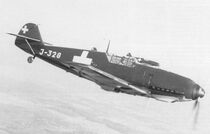
A Bf109E-1 in service of Switzerland.
The initial variant of the Emil, the E-1, was much like its forerunner in armament layout. It was equipped with four MG 17 machine guns; two in the nose cowlings and one in each wing.
Over time, the weapons configuration was modified. The E-2, for example, was issued a 20mm MG FF motorkanone, although this design was short-lived and never reached full production. The E-3 version introduced the new standard format, two MG 17 machine guns in the nose cowlings, and two MG FF canons in the wings. Several of the previous machines were modified to match the E-3.[3]
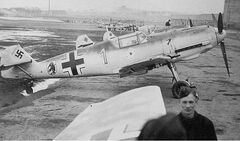
A group of Bf 109E-4s.
The E-4 version made additional modifications to the craft's shape and design. The canopy was a redesigned version with improved armor and visibility. This new design was also slightly more square and simpler to produce.
The Emil's engine was its biggest strength. The Daimler-Benz's fuel injection system allowed the fighter to dive at extreme angles without choking or stalling, unlike craft with gravity-powered carburetors. The Emil could dive with such speed that enemy pilots often mistook them for downed or crashing craft, and marked them as such.[4]
The effective range of the Emil was lackluster, however, often regarded as its worst feature. While it was perfect for the early short-range Blitzkrieg tactics, later battles caused trouble for the fighters. During the Battle of Britain, it was not unheard of for German pilots to glide home with no fuel and land in fields. This problem was remedied by the E-7 version and its inclusion of a 300 liter drop tank, increasing its range from 660 kilometers to 1,325 kilometers.[4] This feature was retained in all later iterations of the Bf 109.
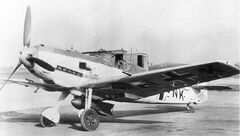
A BF 109E-3 on a runway
Some Emils had their Daimler-Benz 601 engines traded out for the "601N" version, a high-altitude model that usually powered the Bf 110. Fighters of this type had a "/N" suffix in their designation. Fighters designed as Jagdbombers (German: Fighter-Bombers), or Jabos for short, were equipped with under-wing and fuselage bomb racks, and were supplied DB 601Aa engines. These models were assigned the "/B" suffix.[5]
Some examples of the Bf 109E were tropicalized for use in North Africa, the Mediterranean, and the southern parts of the Soviet Union. These fighters were equipped with sand filters in their engines and radiators and were given the "/Trop" suffix.[5]
The Emil was used in a variety of roles. Throughout it's service, it saw use as a day fighter, night fighter, escort fighter, interceptor, photo-reconnaissance aircraft, and fighter-bomber.
History[]
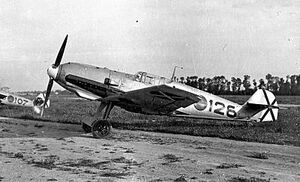
A Bf 109E-1 in Condor Legion colors.
Spain[]
Upon completion of the project, the first batch of Bf 109E-1s saw service with the Condor Legion towards the end of the Spanish Civil War, supplementing the Bertha, Clara, and Dora as the main German fighter. By the time they were delivered, the Republican Air Force was nearly eradicated, so the Emil saw little service in the war.[5]
Poland[]
The next time the Emil saw combat was in September of 1939 during the Invasion of Poland. By this time, many front-line Luftwaffe units had the Emil as their main fighter, while some retained the Dora model. The Polish Air Force, which consisted mostly of the outdated PZL P.11, was completely outclassed by the assault and cleared from the skies. The majority of Bf 109Es lost over Poland were shot down by ground fire and not other aircraft.[6]
The Phoney War, the Low Countries, and France[]
During the Phoney War, the Emil retained its role as front-line fighter and lead the German thrusts into Denmark and Norway. By the start of the Battle of France in 1940, all Luftwaffe day fighter squadrons were operating Emils. The Emils once again outclassed their opposition. While France's Air Force was the first truly modern air force the Luftwaffe ever faced, it still was not much of a challenge. The Bloch MB. 150 was slower and less maneuverable than the Emil, and the Morane-Saulnier M.S.406 was under-armed and under-armored.[7] The imported American Hawk 75s served in relatively small numbers and had a similar fate to the Morane. Beyond that, French squadrons were often forced to abandon their airfields and aircraft to retreat from approaching Wehrmacht ground forces. The new Dewoitine D.520 was the only French fighter capable of combating the Bf 109, but it had just begun to enter service at the time and appeared in very sparse numbers.[4] [8]
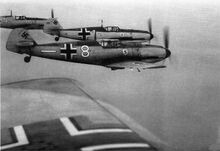
Bf 109E-3s of JG.26 during the Battle of Britain.
The initial confrontations with the RAF were similar to the Emil's previous engagements. The Gloster Gladiators that were stationed in France and the Low Countries were no match for the Bf 109s. And while the Hawker Hurricane Mk. Is were capable of out-turning the German Fighters, they were still unable to catch them.[4]
The first dogfights between Spitfires and Messerschmitts were allowed at Dunkirk, which was close enough to England for the British fighter's limited range. The Spitfires proved a match for the 109s, which attacked in small numbers and suffered proportionately large losses. [5]
Battle of Britain[]
At the start of the Battle of Britain, the Emil was the only single-engined fighter in the Luftwaffe. The German plan of attack was simple; the Bf 110s would escort the bombers, allowing the 109s to rove the battle for targets. However, the 110s proved to be too slow and unmaneuverable to serve as a sufficient escorts, and the 109s were assigned to the role instead. This prevented the 109s from exploiting their strengths over the Spitfires, as they were tied to the bombers.[5]
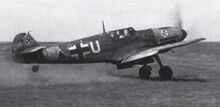
A Bf 109E-7.
The 109s and Spitfires were fairly equivalent in terms of quality and performance. While the Spitfires could turn quicker and roll at a higher rate, the 109Es could climb and dive faster and had a more effective armament. The Spitfire was superior at medium altitude, and the 109 was superior at high altitude. The more common Hurricane Mk. II was similar to the Spitfire, albeit with more machine guns and slightly less agile. However, it was the lack of proper escorts, not the quality of fighters, that lost Germany the battle. At the conclusion of the campaign, the RAF shot down twice as many craft as they lost.[9][Note 1]
Following the Battle of Britain, the Emil was slowly phased out in favor of the updated BF 109F and the brand new Fw 190. The older Emil model served in some capacity for a brief time, mostly in reserve and second-line roles. It saw some limited service in the North African Theater and Operation Barbarossa, until it was completely retired at the end of 1941.[5]
Variants[]
Bf 109E-0: Designation for the pre-production version. This model was identical to the E-1.
Bf 109E-1: The initial version equipped with four MG 17 machine guns and the Daimler-Benz 610A engine. First produced in 1939.
- Bf 109E-1/B: A variant of the E-1 designed as a Jagdbomber or Jabo. This model could be equipped with one 250 kg bomb or four 50 kg bombs. The standard gun-sight doubled as a bomb-sight. The armament. engine, and air frame was kept the same.
Bf 109E-2: An experimental design with the two wing machine guns removed and an MG FF motorkanone in the nose. The motorkanone was found to cause problems and this version never reached production. Ironically, this weapons format was used again for the Friedrich and all following 109 models.
Bf 109E-3: Another main production variant of the Emil. The E-3 was similar to the E-1, but its MG 17 wing guns were replaced with MG FF cannons. The engine was upgraded from a DB 610A to a slightly more powerful DB 610Aa.
Bf 109E-4: A variant based on the E-3. The MG FF wing-cannons were replaced by the faster-firing MG FF/M. The canopy design was changed as well, becoming more boxy and better armored. A large sum of E-3s were modified into this version. This version appeared in 1940 and bore the brunt of the Battle of Britain.
- Bf 109E-4/B: Identical in principle to the E-1/B. but based on the E-4. The craft was unchanged except for the added bomb rack.
- Bf 109E-4/N: A slight modification of the E-4 with the DB 610N engine from the Bf 110 heavy fighter. This engine could provide a one minute boost of emergency power.
- Bf 109E-4/Trop: A tropicalized model with sand filters in the engines.
Bf 109E-5: A photo-reconnaissance variant of the E-4. This version kept the nose-cowling MG 17 machine guns, but had its wing canons removed A camera was mounted in the fuselage for use by the pilot.
Bf 109E-6: A much cheaper and simpler photo-reconnaissance variant based on the E-3. The armament was identical to that of an E-1, the engine was switched out for a DB 610N, and pictures were taken with a hang-held camera.
Bf 109E-7: A long-range version based on the E-4. This variant's range was significantly improved by a 300 liter drop tank that could be attached ventrally. The nose came to a point, closing up the empty socket for the never-fitted Motorkanone. A large number were equipped with the DB 610N instead of the DB 610Aa.
- Bf 109E-7/U2: A standard E-7 with an Umrüst-Bausätze modification kit. The engine armor was increased for low-level ground attacks and strafing runs.
- Bf 109E-7/Z: A variant equipped with a GM-1 nitrous oxide injector, humorously nicknamed the Haha-Gerät (German: Haha Device). This addition could provide a boost of speed and performance for a period of time.
Bf 109E-8: A variant of the E-1, with the same DB 610A and four machine guns, but modified to be equipped with the E-7's 300 liter drop tank.
Bf 109E-9: An version of the E-7 with an automatic camera in the fuselage for reconnaissance.
Other Variants[]
Bf 109T: A short-lived naval variant, designated "Träger", based on the Emil.
Notes[]
- ↑ The 109s actually shot down more collective fighters than the RAF. 109s shot down 219 Spitfires and 272 Hurricanes (491 fighters total). Spitfires shot down 180 Messerschmittss and Hurricanes shot down 153 (333 fighters total). However, the RAF focused on and shot down more German bombers, which won them the battle.
References[]
- ↑ http://www.historyofwar.org/articles/weapons_bf_109E.html
- ↑ http://acepilots.com/german/bf109.html
- ↑ http://militaryhistory.about.com/od/worldwariiaircraft/p/bf109.htm
- ↑ 4.0 4.1 4.2 4.3 http://megalomaniacbore.blogspot.com/2014/10/aircraft-history-bf109.html
- ↑ 5.0 5.1 5.2 5.3 5.4 5.5 http://www.historyofwar.org/articles/weapons_bf_109E.html"
- ↑ http://acepilots.com/german/bf109.html
- ↑ http://www.historyofwar.org/articles/weapons_MS406.html
- ↑ http://www.historyofwar.org/articles/weapons_dewoitine_d520.html
- ↑ http://www.history.co.uk/study-topics/history-of-ww2/battle-of-britain
| ||||||||||||||
